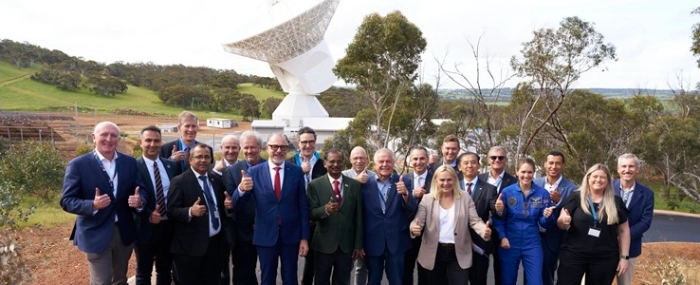
ESA inaugurates deep space antenna in Australia
The new antenna has an estimated construction cost of EUR 62.3 million, covering antenna procurement and construction as well as upgrades to station buildings and services, with a contribution of EUR 3 million from the Australian Space Agency.
The European Space Agency (ESA) has expanded its capability to communicate with scientific, exploration and space safety missions across the Solar System with the inauguration of a new 35-m diameter deep space antenna — the fourth for Estrack, ESA’s deep space tracking network.
Located in New Norcia, about 115 km north of Perth, Western Australia, the ‘New Norcia 3’ antenna will help meet the agency’s fast-increasing data download needs and secure Europe’s independence and leadership in space, ESA said.
The new antenna has an estimated construction cost of EUR 62.3 million, covering antenna procurement and construction as well as upgrades to station buildings and services, with a contribution of EUR 3 million from the Australian Space Agency allocated to the evolution of the New Norcia Station.
“This strategic investment reinforces ESA’s deep-space communication capabilities and maximises the return of our missions’ most valuable asset: data delivered from spacecraft voyaging far from Earth,” Josef Aschbacher, Director General of ESA, said. “New and exciting opportunities between the European and Australian space sectors are opening up with Australia announcing this week a mandate to begin negotiations on a cooperative agreement with ESA.”
The new antenna, as part of the Estrack network, will also serve ESA’s efforts towards international collaboration. As part of mutual cross-support arrangements with the agency’s partners, the new antenna can support other space agencies such as NASA, Japan’s JAXA, and India’s ISRO as well as commercial space missions, boosting science return and operational efficiency for all parties involved, ESA said.
ESA’s fourth deep space antenna, the second one on the site at New Norcia, is the most technologically sophisticated antenna to date. It incorporates advanced deep space communication capabilities, including components cryogenically cooled to around -263°C, near absolute zero. This sensitivity allows it to detect extremely weak signals from distant spacecraft and to maximise data return.
“This investment by ESA and the Australian Government will unlock millions of dollars in local economic value as well as employment over the projected lifetime of 50 years,” Enrico Palermo, Head of the Australian Space Agency (ASA), said. “It’s another chapter in the story of Australian and European partnership in space, which we will grow further as we begin to negotiate a new Cooperation Agreement between Australia and ESA.”

